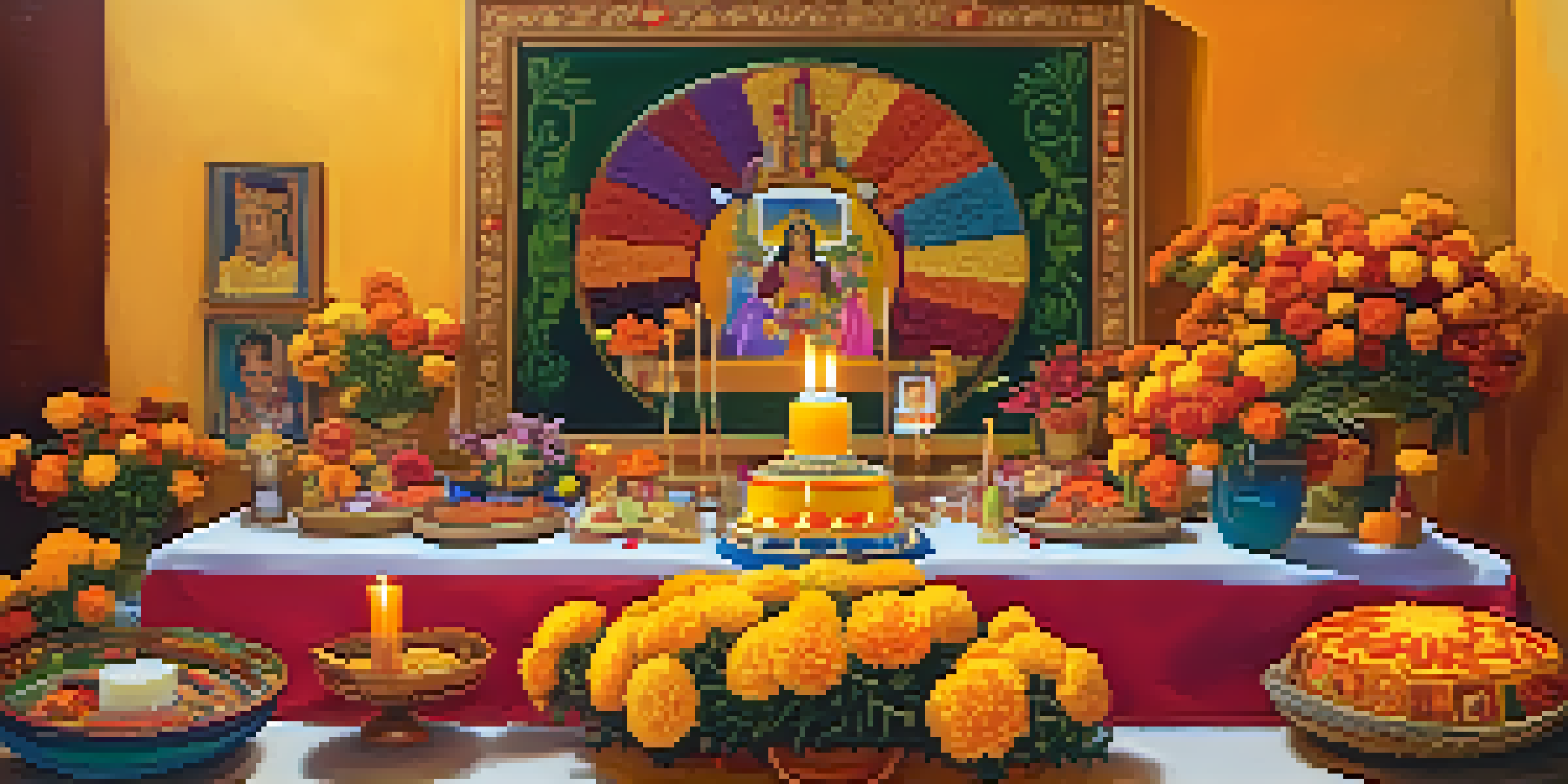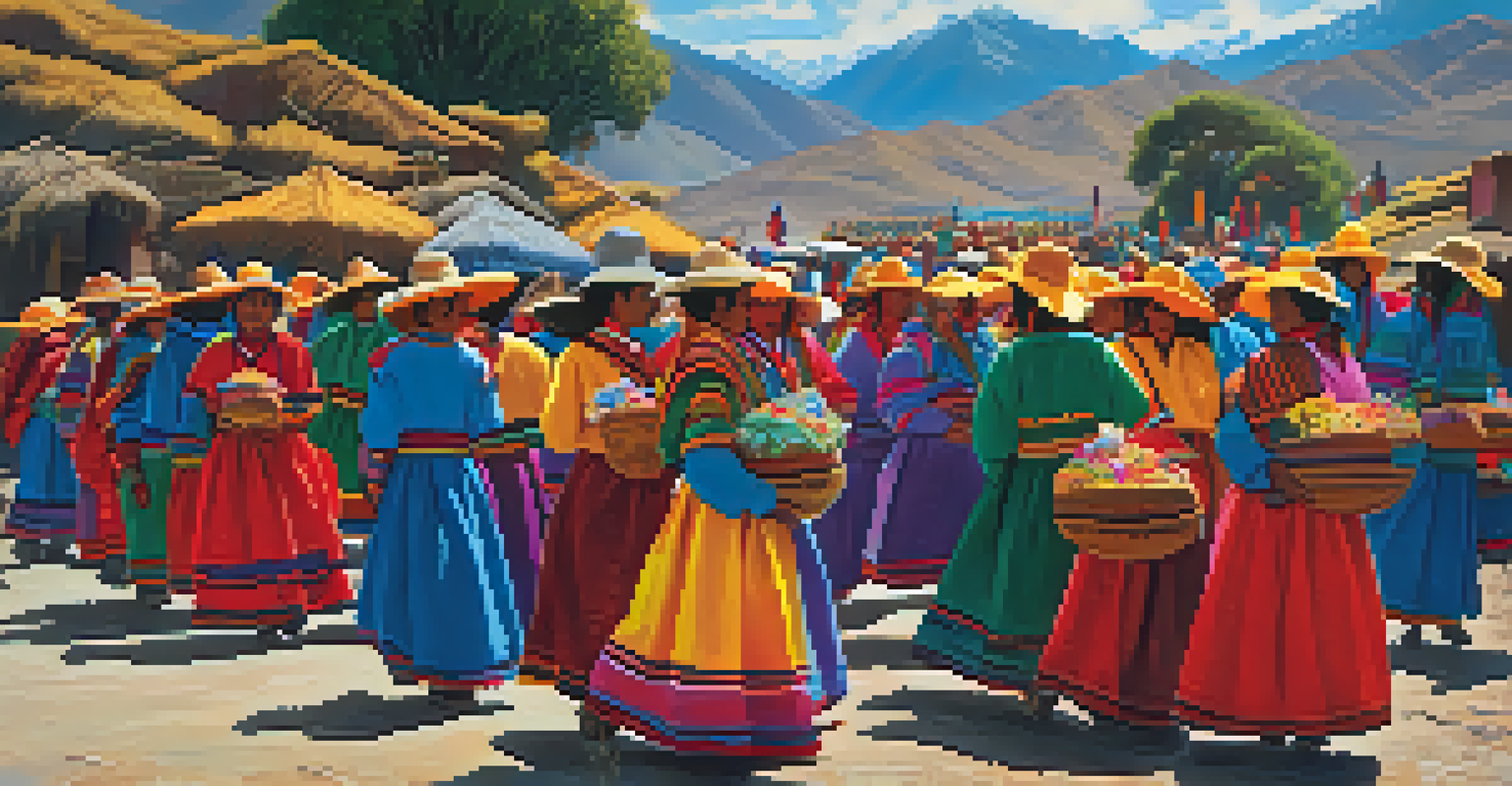Día de Todos los Santos: All Saints' Day in Peru

Understanding Día de Todos los Santos in Peru
Día de Todos los Santos, or All Saints' Day, is a special occasion in Peru, celebrated on November 1st. It honors all saints, known and unknown, who have attained heaven. This day is rooted in both Catholic tradition and indigenous customs, creating a unique blend of cultural practices that reflect Peru's rich history.
To be a saint is to be a light in the darkness, a guide for those who follow.
The celebration marks a time for remembrance and reflection, as families gather to honor their deceased loved ones. Many visit cemeteries, bringing flowers, food, and other offerings to decorate graves. This act signifies their love and respect for those who have passed away, helping to keep their memories alive.
In Peru, the day is not just somber; it's also a festive occasion filled with joy and community. Streets come alive with colorful decorations, and various cultural events often accompany the day, showcasing the vibrant traditions of Peruvian society.
Cultural Traditions and Practices on All Saints' Day
On All Saints' Day, it is common for families to prepare traditional dishes such as 'turrón de dulce' and 'pan de muerto.' These sweet treats are often shared among family members and symbolize the sweetness of life and remembrance. Preparing these foods can be a communal activity, strengthening family bonds during this reflective time.

In many regions of Peru, especially in the highlands, people also participate in processions and mass services. These gatherings not only honor the saints but also serve as an opportunity for community members to come together in faith and solidarity. It reinforces the sense of belonging and shared values among the participants.
A Blend of Cultures and Traditions
Día de Todos los Santos in Peru combines Catholic and indigenous customs, creating a rich cultural celebration.
Another unique aspect of the celebration is the use of altars, or 'ofrendas,' dedicated to the departed. Families create these elaborate displays, adorned with photos, candles, and favorite foods of the deceased, inviting their spirits to join in the celebration. This practice illustrates the deep connection between the living and the dead in Peruvian culture.
The Role of Religion in All Saints' Day Celebrations
Día de Todos los Santos is deeply intertwined with Catholic beliefs, reflecting the importance of spirituality in Peruvian life. Many Peruvians attend church services to pray for the souls of their loved ones, seeking blessings and peace for the departed. This religious aspect reinforces the significance of faith in navigating the cycle of life and death.
Memory is the treasure house of the mind wherein the monuments thereof are kept and preserved.
Churches often hold special masses in honor of the saints, filled with prayers, hymns, and sometimes even traditional music. These services create a sacred atmosphere that enhances the spiritual experience of the day, allowing attendees to reflect on their faith and the lives of those they honor.
Moreover, the celebration encourages individuals to consider the concept of sainthood itself, prompting discussions about virtue, morality, and legacy. It serves as a reminder for many to strive for a life that honors the values and teachings of the saints, making the day not only about remembrance but also about inspiration.
The Significance of Altars and Offerings
Creating altars, or 'ofrendas,' is a cherished tradition during All Saints' Day in Peru. These altars serve as a focal point for remembrance and offer a tangible connection to the deceased. Families take great care in decorating them, using items that reflect the personalities and preferences of their loved ones.
Common offerings placed on these altars include flowers, especially marigolds, which symbolize the fragility of life. Additionally, favorite foods and beverages of the departed are often included, representing the idea that the spirits can partake in the celebration. This practice creates a sense of presence, allowing families to feel close to those who have passed.
Significance of Altars and Offerings
Families create elaborate altars, or 'ofrendas,' to honor their deceased, fostering connection and remembrance.
The act of building and tending to these altars is also a way for families to share stories and memories, fostering a sense of intergenerational connection. It becomes a time for storytelling and bonding, as younger family members learn about their ancestors and the values they upheld.
Local Variations: Regional Differences in Celebrations
While the core of Día de Todos los Santos remains consistent across Peru, various regions celebrate with unique customs. In coastal areas, for instance, families may host beach gatherings, incorporating seafood into their offerings. This reflects the local culture and the influence of the sea on their lives.
In contrast, Andean communities often emphasize traditional music and dance during their celebrations. Events might include communal gatherings where people share food, engage in folk dances, and play traditional instruments, all while honoring their ancestors. This regional flair adds diversity and richness to the overall celebration.
These local variations highlight how the essence of All Saints' Day is adapted to fit the cultural context of each community. It underscores the flexibility of traditions, allowing them to evolve while still maintaining their fundamental purpose of honoring the departed.
The Influence of Indigenous Beliefs on All Saints' Day
Indigenous beliefs play a significant role in shaping the way Día de Todos los Santos is celebrated in Peru. Many elements of the celebration, such as the use of altars and offerings, can be traced back to pre-Columbian practices. This fusion of Catholicism with indigenous spirituality creates a rich tapestry of cultural expressions.
For instance, the reverence for nature and ancestral spirits is a common theme in both indigenous and Catholic traditions. Families may incorporate elements like earth, water, and fire into their offerings, reflecting a holistic view of life and death. This connection to nature underscores the importance of harmony and balance in these celebrations.
Regional Variations Enrich Celebrations
Different regions in Peru celebrate All Saints' Day with unique customs that reflect local cultures and traditions.
As a result, Día de Todos los Santos becomes a day not only for remembering the dead but also for celebrating the continuity of life itself. The blending of beliefs illustrates how cultures can coexist and influence one another, enriching the experiences of those who partake in the festivities.
Final Thoughts: The Legacy of Día de Todos los Santos
Día de Todos los Santos is more than just a day of remembrance; it is a celebration of life, love, and community. Through its rich traditions and diverse practices, it offers a unique opportunity for families to connect with their past and share their stories. This legacy continues to thrive, ensuring that the memories of loved ones endure.
As Peruvians gather to honor their saints and ancestors, they also reinforce the values of family and togetherness. The warmth and joy that permeate the celebrations remind everyone of the importance of cherishing relationships, both with the living and the departed.

In an ever-changing world, Día de Todos los Santos stands as a testament to the resilience of culture and tradition. It invites each generation to remember, reflect, and celebrate the lives that have shaped their own, fostering a sense of continuity that is vital to the Peruvian identity.